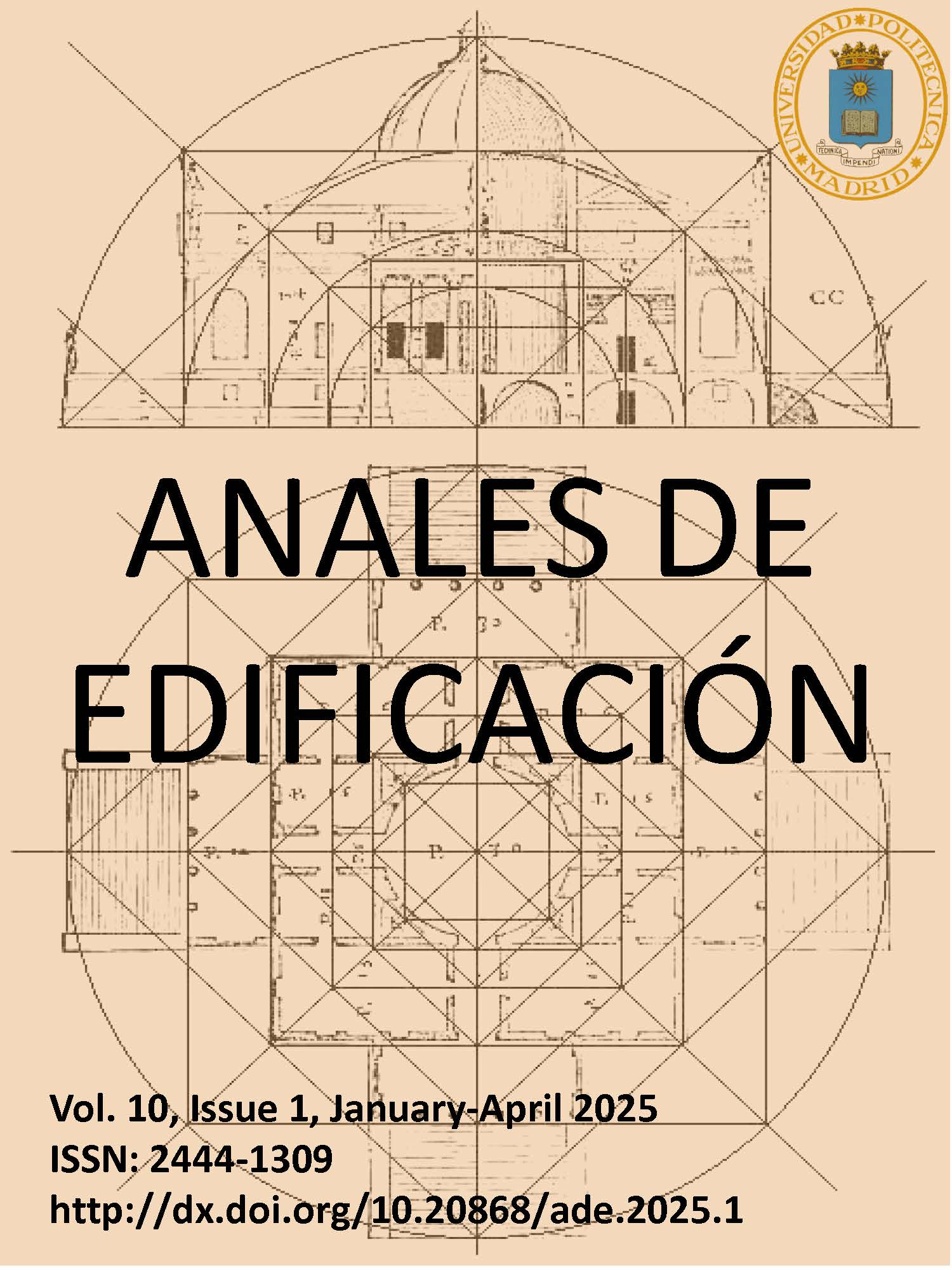FRCM Composites para aplicaciones estructurales: una revisión sistemática
DOI:
https://doi.org/10.20868/ade.2025.5386Palabras clave:
Matriz cementosa reforzada con fibras, Resistencia a la tracción, Resistencia a la flexión, Sistema de retroadaptaciónResumen
Las matrices cementosas reforzadas con fibras (MCRF) son materiales compuestos que se utilizan cada vez más para la rehabilitación de estructuras existentes debido a su elevada relación resistencia-peso. Las FRCM están formadas por un tejido embebido en una matriz de mortero. Generalmente, el textil es una rejilla ortogonal que puede estar hecha de fibras de carbono, vidrio resistente a los álcalis (AR), basalto, aramida o PBO. Los morteros pueden ser a base de cal o cementosos, y pueden incluir varias adiciones como polímeros, fibras y cenizas volantes.
En este trabajo, para investigar sistemáticamente el comportamiento mecánico de los materiales compuestos FRCM sometidos a esfuerzos de tracción, así como el comportamiento en la interfaz FRCM-hormigón sometida a flexión, se realizó una revisión exhaustiva de los estudios experimentales.
Se diseñó un protocolo para la revisión sistemática, en el que la selección de artículos estuvo motivada por la inclusión de investigaciones experimentales, dentro del corpus de Web of Science de artículos que trataban sobre materiales FRCM de carbono, mediante la inclusión de «carbono» en el resumen o en el título.
Descargas
Referencias
1. Akbari Hadad, H., Erickson, B., & Nanni, A. (2020). Flexural analysis and design of FRCM-strengthened RC beams. Construction and Building Materials, 244, 118371. https://doi.org/10.1016/j.conbuildmat.2020.118371
2. Akbari Hadad, H., Nanni, A., Ebead, U. A., & El Refai, A. (2018). Static and Fatigue Performance of FRCM-Strengthened Concrete Beams. Journal of Composites for Construction, 22(5). https://doi.org/10.1061/(ASCE)CC.1943-5614.0000868
3. Arboleda, D. (2014). Fabric reinforced cementitious matrix (FRCM) composites for infrastructure strengthening and rehabilitation: Characterization methods. In Faculty of the University of Miami (Issue October 2013).
4. Arboleda, D., Carozzi, F. G., Nanni, A., & Poggi, C. (2016). Testing Procedures for the Uniaxial Tensile Characterization of Fabric-Reinforced Cementitious Matrix Composites. Journal of Composites for Construction, 20(3), 04015063. https://doi.org/10.1061/(ASCE)CC.1943-5614.0000626
5. Ascione, L., De Felice, G., & De Santis, S. (2015). A qualification method for externally bonded Fibre Reinforced Cementitious Matrix (FRCM) strengthening systems. Composites Part B: Engineering, 78, 497–506. https://doi.org/10.1016/j.compositesb.2015.03.079
6. Awani, O., Refai, A. El, & El-Maaddawy, T. (2015). Bond characteristics of carbon fabric-reinforced cementitious matrix in double shear tests. Construction and Building Materials, 101, 39–49. https://doi.org/10.1016/j.conbuildmat.2015.10.017
7. Bellini, A., Bovo, M., & Mazzotti, C. (2019). Experimental and numerical evaluation of fiber-matrix interface behaviour of different FRCM systems. Composites Part B: Engineering, 161, 411–426. https://doi.org/10.1016/j.compositesb.2018.12.115
8. Bertolesi, E., Carozzi, F. G., Milani, G., & Poggi, C. (2014). Numerical modeling of Fabric Reinforce Cementitious Matrix composites (FRCM) in tension. Construction and Building Materials, 70, 531–548. https://doi.org/10.1016/j.conbuildmat.2014.08.006
9. Bilotta, A., Ceroni, F., Lignola, G. P., & Prota, A. (2017). Use of DIC technique for investigating the behaviour of FRCM materials for strengthening masonry elements. Composites Part B: Engineering, 129, 251–270. https://doi.org/10.1016/j.compositesb.2017.05.075
10. Bressan, J., Ghrib, F., & El Ragaby, A. (2022). FRCM Strengthening of Corrosion-Damaged RC Beams Subjected to Monotonic and Cyclic Loading. Journal of Composites for Construction, 26(1). https://doi.org/10.1061/(ASCE)CC.1943-5614.0001180
11. Butler, M., Mechtcherine, V., & Hempel, S. (2010). Durability of textile reinforced concrete made with AR glass fibre: Effect of the matrix composition. Materials and Structures/Materiaux et Constructions, 43(10), 1351–1368. https://doi.org/10.1617/s11527-010-9586-8
12. Caggegi, C., Carozzi, F. G., De Santis, S., Fabbrocino, F., Focacci, F., Hojdys, Ł., Lanoye, E., & Zuccarino, L. (2017). Experimental analysis on tensile and bond properties of PBO and aramid fabric reinforced cementitious matrix for strengthening masonry structures. Composites Part B: Engineering, 127, 175–195. https://doi.org/10.1016/j.compositesb.2017.05.048
13. Caggegi, C., Lanoye, E., Djama, K., Bassil, A., & Gabor, A. (2017). Tensile behaviour of a basalt TRM strengthening system: Influence of mortar and reinforcing textile ratios. Composites Part B: Engineering, 130, 90–102. https://doi.org/10.1016/j.compositesb.2017.07.027
14. Carozzi, F. G., Bellini, A., D’Antino, T., de Felice, G., Focacci, F., Hojdys, Ł., Laghi, L., Lanoye, E., Micelli, F., Panizza, M., & Poggi, C. (2017a). Experimental investigation of tensile and bond properties of Carbon-FRCM composites for strengthening masonry elements. Composites Part B: Engineering, 128, 100–119. https://doi.org/10.1016/j.compositesb.2017.06.018
15. Carozzi, F. G., Bellini, A., D’Antino, T., de Felice, G., Focacci, F., Hojdys, Ł., Laghi, L., Lanoye, E., Micelli, F., Panizza, M., & Poggi, C. (2017b). Experimental investigation of tensile and bond properties of Carbon-FRCM composites for strengthening masonry elements. Composites Part B: Engineering, 128, 100–119. https://doi.org/10.1016/j.compositesb.2017.06.018
16. Carozzi, F. G., & Poggi, C. (2015). Mechanical properties and debonding strength of Fabric Reinforced Cementitious Matrix (FRCM) systems for masonry strengthening. Composites Part B: Engineering, 70, 215–230. https://doi.org/10.1016/j.compositesb.2014.10.056
17. Choi, D., Vachirapanyakun, S., Ochirbud, M., Naidangjav, U., Ha, S., & Kim, Y. (2021). Tensile Performance, Lap-Splice Length and Behavior of Concretes Confined by Prefabricated C-FRCM System. International Journal of Concrete Structures and Materials, 15(1), 45. https://doi.org/10.1186/s40069-021-00481-w
18. Guide for the design and construction of externally bonded FRP systems for strengthening existing structures, ACI committee 440 144 (2018).
19. D’Ambrisi, A., Feo, L., & Focacci, F. (2013). Experimental and analytical investigation on bond between Carbon-FRCM materials and masonry. Composites Part B: Engineering, 46, 15–20. https://doi.org/10.1016/j.compositesb.2012.10.018
20. D’Antino, T., & Papanicolaou, C. (2017). Mechanical characterization of textile reinforced inorganic-matrix composites. Composites Part B: Engineering, 127, 78–91. https://doi.org/10.1016/j.compositesb.2017.02.034
21. D’Antino, Tommaso, Carloni, C., Sneed, L. H., & Pellegrino, C. (2014). Matrix-fiber bond behavior in PBO FRCM composites: A fracture mechanics approach. Engineering Fracture Mechanics, 117, 94–111. https://doi.org/10.1016/j.engfracmech.2014.01.011
22. D’Antino, Tommaso, & Papanicolaou, C. (2017). Mechanical characterization of textile reinforced inorganic-matrix composites. Composites Part B: Engineering, 127, 78–91. https://doi.org/10.1016/j.compositesb.2017.02.034
23. D’Antino, Tommaso, & Papanicolaou, C. (Corina). (2018). Comparison between different tensile test set-ups for the mechanical characterization of inorganic-matrix composites. Construction and Building Materials, 171, 140–151. https://doi.org/10.1016/j.conbuildmat.2018.03.041
24. De Domenico, D., Maugeri, N., Longo, P., Ricciardi, G., Gullì, G., & Calabrese, L. (2022). Clevis-Grip Tensile Tests on Basalt, Carbon and Steel FRCM Systems Realized with Customized Cement-Based Matrices. Journal of Composites Science, 6(9), 275. https://doi.org/10.3390/jcs6090275
25. de Felice, G., D’Antino, T., De Santis, S., Meriggi, P., & Roscini, F. (2020). Lessons Learned on the Tensile and Bond Behavior of Fabric Reinforced Cementitious Matrix (FRCM) Composites. Frontiers in Built Environment, 6. https://doi.org/10.3389/fbuil.2020.00005
26. de Felice, G., De Santis, S., Garmendia, L., Ghiassi, B., Larrinaga, P., Lourenço, P. B., Oliveira, D. V., Paolacci, F., & Papanicolaou, C. G. (2014). Mortar-based systems for externally bonded strengthening of masonry. Materials and Structures/Materiaux et Constructions, 47(12), 2021–2037. https://doi.org/10.1617/s11527-014-0360-1
27. De Santis, S., & De Felice, G. (2015). Tensile behaviour of mortar-based composites for externally bonded reinforcement systems. Composites Part B: Engineering, 68, 401–413. https://doi.org/10.1016/j.compositesb.2014.09.011
28. De Santis, S., Hadad, H. A., De Caso y Basalo, F., de Felice, G., & Nanni, A. (2018). Acceptance Criteria for Tensile Characterization of Fabric-Reinforced Cementitious Matrix Systems for Concrete and Masonry Repair. Journal of Composites for Construction, 22(6), 04018048. https://doi.org/10.1061/(asce)cc.1943-5614.0000886
29. Donnini, J., Chiappini, G., Lancioni, G., & Corinaldesi, V. (2019). Tensile behaviour of glass FRCM systems with fabrics’ overlap: Experimental results and numerical modeling. Composite Structures, 212(October 2018), 398–411. https://doi.org/10.1016/j.compstruct.2019.01.053
30. Donnini, J., Corinaldesi, V., & Nanni, A. (2016). Mechanical properties of FRCM using carbon fabrics with different coating treatments. Composites Part B: Engineering, 88, 220–228. https://doi.org/10.1016/j.compositesb.2015.11.012
31. Ebead, U., & El-Sherif, H. (2019). Near surface embedded-FRCM for flexural strengthening of reinforced concrete beams. Construction and Building Materials, 204, 166–176. https://doi.org/10.1016/j.conbuildmat.2019.01.145
32. Ebead, U., Shrestha, K. C., Afzal, M. S., El Refai, A., & Nanni, A. (2017). Effectiveness of Fabric-Reinforced Cementitious Matrix in Strengthening Reinforced Concrete Beams. Journal of Composites for Construction, 21(2), 04016084. https://doi.org/10.1061/(asce)cc.1943-5614.0000741
33. El-Sherif, H., Wakjira, T. G., & Ebead, U. (2020). Flexural strengthening of reinforced concrete beams using hybrid near-surface embedded/externally bonded fabric-reinforced cementitious matrix. Construction and Building Materials, 238, 117748. https://doi.org/10.1016/j.conbuildmat.2019.117748
34. Elghazy, M., El Refai, A., Ebead, U., & Nanni, A. (2017). Effect of corrosion damage on the flexural performance of RC beams strengthened with FRCM composites. Composite Structures, 180, 994–1006. https://doi.org/10.1016/j.compstruct.2017.08.069
35. Elghazy, M., El Refai, A., Ebead, U., & Nanni, A. (2018). Corrosion-Damaged RC Beams Repaired with Fabric-Reinforced Cementitious Matrix. Journal of Composites for Construction, 22(5). https://doi.org/10.1061/(ASCE)CC.1943-5614.0000873
36. Escrig, C., Gil, L., Bernat-Maso, E., & Puigvert, F. (2015). Experimental and analytical study of reinforced concrete beams shear strengthened with different types of textile-reinforced mortar. Construction and Building Materials, 83, 248–260. https://doi.org/10.1016/j.conbuildmat.2015.03.013
37. Estevan, L., Varona, F. B., Baeza, F. J., Torres, B., & Bru, D. (2022). Textile Reinforced Mortars (TRM) tensile behavior after high temperature exposure. Construction and Building Materials, 328, 127116.
38. FRCM Composites para aplicaciones estructurales: una revisión sistemática FRCM Composites for structural applications: a systematic review https://doi.org/10.1016/j.conbuildmat.2022.127116
39. Feng, R., Liu, Y., Zhu, J.-H., & Xing, F. (2020). Flexural behaviour of C-FRCM strengthened corroded RC continuous beams. Composite Structures, 245, 112200. https://doi.org/10.1016/j.compstruct.2020.112200
40. Hartig, J., Jesse, F., Schicktanz, K., & Häußler-Combe, U. (2012). Influence of experimental setups on the apparent uniaxial tensile load-bearing capacity of Textile Reinforced Concrete specimens. Materials and Structures/Materiaux et Constructions, 45(3), 433–446. https://doi.org/10.1617/s11527-011-9775-0
41. Jabr, A., El-Ragaby, A., & Ghrib, F. (2017). Effect of the Fiber Type and Axial Stiffness of FRCM on the Flexural Strengthening of RC Beams. Fibers, 5(1), 2. https://doi.org/10.3390/fib5010002
42. Khattak, N., Mansour, M., El-Maaddawy, T., & Ismail, N. (2021). Continuous Reinforced Concrete Beams Strengthened with Fabric-Reinforced Cementitious Matrix: Experimental Investigation and Numerical Simulation. Buildings, 12(1), 27. https://doi.org/10.3390/buildings12010027
43. Kim, H.-S., Truong, G. T., Park, S.-H., & Choi, K.-K. (2018). Tensile Properties of Carbon Fiber-Textile Reinforced Mortar (TRM) Characterized by Different Anchorage Methods. International Journal of Concrete Structures and Materials, 12(1), 73. https://doi.org/10.1186/s40069-018-0296-x
44. Kim, H.-Y., You, Y.-J., & Ryu, G.-S. (2021). Reinforced Concrete Slabs Strengthened with Carbon Textile Grid and Cementitious Grout. Materials, 14(17), 5046. https://doi.org/10.3390/ma14175046
45. Kim, H.-Y., You, Y.-J., & Ryu, G.-S. (2022). Flexural Strengthening of RC Slabs with Lap-Spliced Carbon Textile Grids and Cementitious Grout. Materials, 15(8), 2849. https://doi.org/10.3390/ma15082849
46. Kim, H.-Y., You, Y.-J., Ryu, G.-S., Koh, K.-T., Ahn, G.-H., & Kang, S.-H. (2020). Flexural Strengthening of Concrete Slab-Type Elements with Textile Reinforced Concrete. Materials, 13(10), 2246. https://doi.org/10.3390/ma13102246
47. Leone, M., Aiello, M. A., Balsamo, A., Carozzi, F. G., Ceroni, F., Corradi, M., Gams, M., Garbin, E., Gattesco, N., Krajewski, P., Mazzotti, C., Oliveira, D., Papanicolaou, C., Ranocchiai, G., Roscini, F., & Saenger, D. (2017). Glass fabric reinforced cementitious matrix: Tensile properties and bond performance on masonry substrate. Composites Part B: Engineering, 127, 196–214. https://doi.org/10.1016/j.compositesb.2017.06.028
48. Lignola, G. P., Caggegi, C., Ceroni, F., De Santis, S., Krajewski, P., Lourenço, P. B., Morganti, M., Papanicolaou, C. (Corina), Pellegrino, C., Prota, A., & Zuccarino, L. (2017). Performance assessment of basalt FRCM for retrofit applications on masonry. Composites Part B: Engineering, 128, 1–18. https://doi.org/10.1016/j.compositesb.2017.05.003
49. Mandor, A., & El Refai, A. (2022). Strengthening the hogging and sagging regions in continuous beams with fiber-reinforced cementitious matrix (FRCM): Experimental and analytical investigations. Construction and Building Materials, 321, 126341. https://doi.org/10.1016/j.conbuildmat.2022.126341
50. Mazzucco, G., D’Antino, T., Pellegrino, C., & Salomoni, V. (2018). Three-dimensional finite element modeling of inorganic-matrix composite materials using a mesoscale approach. Composites Part B: Engineering, 143(December 2017), 75–85. https://doi.org/10.1016/j.compositesb.2017.12.057
51. Ombres, L. (2015). Analysis of the bond between Fabric Reinforced Cementitious Mortar (FRCM) strengthening systems and concrete. Composites Part B: Engineering, 69, 418–426. https://doi.org/10.1016/j.compositesb.2014.10.027
52. Ombres, L., Mancuso, N., Mazzuca, S., & Verre, S. (2019). Bond between Carbon Fabric-Reinforced Cementitious Matrix and Masonry Substrate. Journal of Materials in Civil Engineering, 31(1), 04018356. https://doi.org/10.1061/(ASCE)MT.1943-5533.0002561
53. Papanicolaou, C G, & Papantoniou, I. C. (2016). Optimum design of textile-reinforced concrete as integrated formwork in slabs. In Textile Fibre Composites in Civil Engineering (pp. 246–274).
54. Papanicolaou, Catherine G., Triantafillou, T. C., Papathanasiou, M., & Karlos, K. (2008). Textile reinforced mortar (TRM) versus FRP as strengthening material of URM walls: Out-of-plane cyclic loading. Materials and Structures/Materiaux et Constructions, 41(1), 143–157. https://doi.org/10.1617/s11527-007-9226-0
55. Peled, A., & Bentur, A. (2000). Geometrical characteristics and efficiency of textile fabrics for reinforcing cement composites. Cement and Concrete Research, 30(5), 781–790. https://doi.org/10.1016/S0008-8846(00)00239-8
56. Peled, A., Cohen, Z., Pasder, Y., Roye, A., & Gries, T. (2008). Influences of textile characteristics on the tensile properties of warp knitted cement based composites. Cement and Concrete Composites, 30(3), 174–183. https://doi.org/10.1016/j.cemconcomp.2007.09.001
57. Peled, A., Mobasher, B., & Bentur, A. (2017). Textile reinforced concrete. In Textile Reinforced Concrete (1st editio). CRC Press. https://doi.org/10.1201/9781315119151
58. Raoof, S. M., & Bournas, D. A. (2017). TRM versus FRP in flexural strengthening of RC beams: Behaviour at high temperatures. Construction and Building Materials, 154, 424–437. https://doi.org/10.1016/j.conbuildmat.2017.07.195
59. Raoof, S. M., Koutas, L. N., & Bournas, D. A. (2017). Textile-reinforced mortar (TRM) versus fibre-reinforced polymers (FRP) in flexural strengthening of RC beams. Construction and Building Materials, 151, 279–291. https://doi.org/10.1016/j.conbuildmat.2017.05.023
60. Rodríguez-Marcos, M., Villanueva-Llaurado, P., Fernández-Gómez, J., & López–Rebollo, J. (2023). Improvement of tensile properties of carbon fibre-reinforced cementitious matrix composites with coated textile and enhanced mortars. Construction and Building Materials,
61. 369(February), 130552. https://doi.org/10.1016/j.conbuildmat.2023.130552
62. Su, Mei-ni, Wei, L., Zeng, Z., Ueda, T., Xing, F., & Zhu, J.-H. (2019). A solution for sea-sand reinforced concrete beams. Construction and Building Materials, 204, 586–596. https://doi.org/10.1016/j.conbuildmat.2019.01.146
63. Su, Mei-ni, Wei, L., Zhu, J.-H., Ueda, T., Guo, G., & Xing, F. (2019). Combined Impressed Current Cathodic Protection and FRCM Strengthening for Corrosion-Prone Concrete Structures. Journal of Composites for Construction, 23(4). https://doi.org/10.1061/(ASCE)CC.1943-5614.0000949
64. Su, Mei-ni, Zeng, C., Li, W., Zhu, J.-H., Lin, W., Ueda, T., & Xing, F. (2020). Flexural performance of corroded continuous RC beams rehabilitated by ICCP-SS. Composite Structures, 232, 111556. https://doi.org/10.1016/j.compstruct.2019.111556
65. Su, Mei ni, Wang, Z., & Ueda, T. (2022). Optimization and design of carbon fabric-reinforced cementitious matrix composites. Structural Concrete, 23(3), 1845–1860. https://doi.org/10.1002/suco.202000801
66. Tekieli, M., De Santis, S., de Felice, G., Kwiecień, A., & Roscini, F. (2017). Application of Digital Image Correlation to composite reinforcements testing. Composite Structures, 160, 670–688. https://doi.org/10.1016/j.compstruct.2016.10.096
67. Tetta, Z. C., & Bournas, D. A. (2016). TRM vs FRP jacketing in shear strengthening of concrete members subjected to high temperatures. Composites Part B: Engineering, 106, 190–205. https://doi.org/10.1016/j.compositesb.2016.09.026
68. Tran, H. Van, Truong, G. T., & Choi, K.-K. (2019). Effect of Harsh Conditions on the Tensile Behaviour of Lap-Spliced Carbon Fiber Textile-Reinforced Mortar (TRM) with Different Surface Treatment Methods. Applied Sciences, 9(15), 3087. https://doi.org/10.3390/app9153087Truong, V. D., Lee, D. H., & Kim, D. J. (2021). Effects of different grips and surface treatments of textile on measured direct tensile response of textile reinforced cementitious composites. Composite Structures, 278, 114689. https://doi.org/10.1016/j.compstruct.2021.114689
69. Valluzzi, M. R., Modena, C., & de Felice, G. (2014). Current practice and open issues in strengthening historical buildings with composites. Materials and Structures/Materiaux et Constructions, 47(12), 1971–1985. https://doi.org/10.1617/s11527-014-0359-7
70. Wei, L. L., Zhu, J. H., Ueda, T., Su, M. N., Liu, J., Liu, W., Tang, L. P., & Xing, F. (2020). Tensile behaviour of carbon fabric reinforced cementitious matrix composites as both strengthening and anode materials. Composite Structures, 234. https://doi.org/10.1016/j.compstruct.2019.111675
71. Wei, L., Ueda, T., Matsumoto, K., & Zhu, J.-H. (2021). Experimental and analytical study on the behavior of RC beams with externally bonded carbon-FRCM composites. Composite Structures, 273, 114291. https://doi.org/10.1016/j.compstruct.2021.114291
72. Younis, A., Ebead, U., & Shrestha, K. (2020). Tensile characterization of multi‐ply fabric‐reinforced cementitious matrix strengthening systems. Structural Concrete, 21(2), 713–723. https://doi.org/10.1002/suco.201900076
Descargas
Publicado
Número
Sección
Licencia
Derechos de autor 2025 Autor / BY-NC

Esta obra está bajo una licencia internacional Creative Commons Atribución-NoComercial-SinDerivadas 4.0.
1. Los autores conservan los derechos de autor y garantizan a la revista el derecho de una Licencia Creative Commons Atribución - Nocomercial 4.0 Internacional que permite a otros compartir el trabajo con un reconocimiento de la autoría y uso no comercial.
2. Los autores pueden establecer por separado acuerdos adicionales para la distribución no exclusiva de la versión de la obra publicada en la revista (por ejemplo, situarlo en un repositorio institucional o publicarlo en un libro).
Salvo indicación contraria, todos los contenidos de la edición electrónica se distribuyen bajo una licencia de uso y distribución “Creative Commons"












